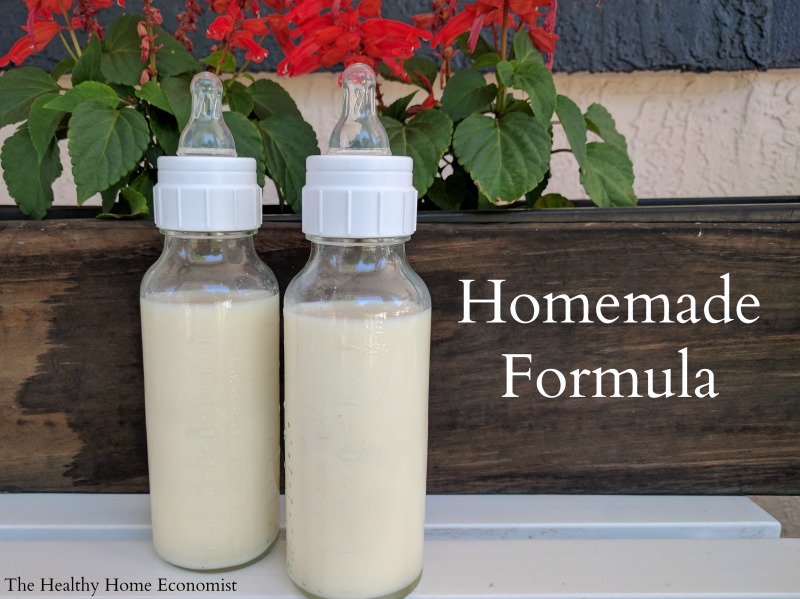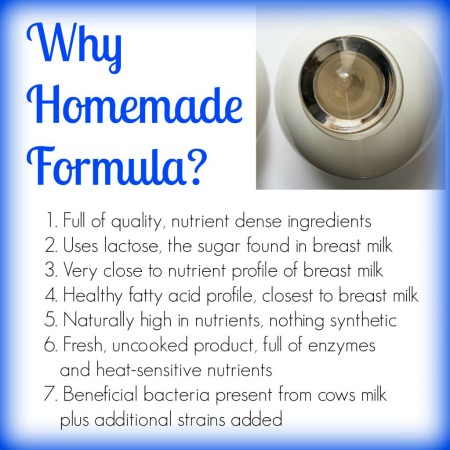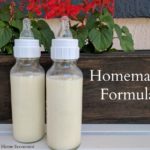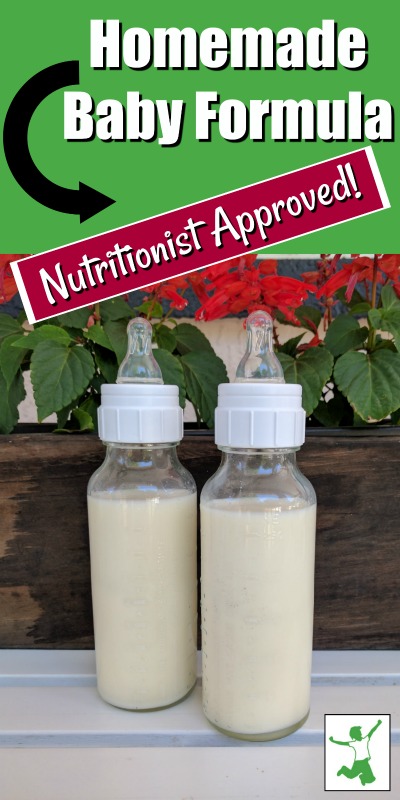Table of Contents[Hide][Show]
A nourishing homemade baby formula using safe, whole ingredients. This recipe was developed and tested by Dr. Mary Enig, a PhD Nutritionist and originally published in Nourishing Traditions cookbook in 1996. It was formulated to match breastmilk as closely as possible and is also suitable for infants. Source: Weston A. Price Foundation

There is no doubt that breastfeeding your baby is the best option for the child’s long-term health and development. Human breastmilk from a well-nourished mother is the perfect food for baby. However, in circumstances where the child is adopted or the Mother finds herself unable to breastfeed, formula feeding becomes necessary. In those cases, homemade baby formula is best.
Using a baby formula recipe that closely matches the nutritional profile of breastmilk is a far better choice than even organic baby formula from the health food store. More on this below.
Note: Donor programs are widely available for human breastmilk. But, the diets of the donor mothers are unknown and most likely nutritionally insufficient. In addition, breastmilk banks pasteurize the donated breastmilk which destroys much of the nutritional benefit. Unless you are fortunate to have a trusted and direct donor milk source in your community, avoid this option!
Dangers of Commercial Formula
Commercial formulas are always a poor choice for a number of reasons. First of all, formula manufacturers line the cans with the chemical BPA. This substance disrupts hormone development and is a probable contributor to early puberty in girls, and ADHD, urogenital abnormalities, and other ills in boys.
The European Food Safety Authority found that canned commercial formula is a significant source of BPA for infants, exposing the child to 13mcg of BPA per kg of body weight per day! BPA-free formula cans are no better. The chemical BPS is typically used instead which is just as dangerous.
Beware that manufacturers pack even organic commercial formula like Earth’s Best in BPA cans. Worse, they use organic brown rice syrup as the primary sweetener which is known to be frequently contaminated with arsenic.
In addition, all commercial milk formulas are processed at extremely high temperatures which violently denature the fragile milk proteins, render them allergenic, and add carcinogens to the final product. Soy infant formula is the worst. Obscenely high processing temperatures not only denature the proteins but large levels of phytic acid in soy block mineral absorption by the infant. Moreover, soy-based plant estrogens disrupt the hormonal development of the baby!
It seems that for the concerned Mother who is unable to breastfeed, learning how to make baby formula at home with safe, pure ingredients is the most prudent way to go!
Why Make Homemade Formula Even if You Are Breastfeeding
In the video below, I show you how to make your own safe, healthy raw milk homemade formula for your baby.
The recipe I follow was originally published in the cookbook Nourishing Traditions in 1996 and developed by Dr. Mary Enig.
Even though I breastfed each of my children for at least 2 years, I made this exact formula for my own children when I was away for the day or the evening as pumping was not an option that worked well for me.
I even used this homemade formula for an entire day once when I had some dental work done and was advised to pump and discard for 24 hours.
As a result, even successfully breastfeeding Moms can use this wonderful homemade formula as a supplement when necessary to their own nutrient-dense breastmilk!
It is advised that even breastfeeding Mothers have the ingredients for this formula on hand for an emergency. If Mom is sick or otherwise unable to nurse, Dad can step in and make this safe alternative until Mom is back on her feet. It takes a few days to a week to gather all the ingredients together to make this formula, which is why I advise having them on hand at all times.
Homemade Most Nutritious
The image below lists the reasons why it is worth it nutritionally to make formula yourself for your precious baby!
You can order all of the required ingredients for the homemade baby formula in one package from this reputable, vetted source.
Moms who have successfully used this formula feeding your children, please post about your experience in the comments section to encourage those who are considering it and need some Mom to Mom encouragement!

Where to Source Quality Milk
The most widely available grass-fed milk around the world is from cows. This is usually the most budget-friendly and easily sourced milk for this recipe for homemade formula.
If only goat milk is available in your area, this recipe for goat milk baby formula can be used instead. When using milk from ewes, please refer to the linked article for an adjusted recipe; one of the benefits of sheep milk is that it is higher in healthy fats than either goat or cow milk.
Camel milk formula is another option that is a particularly digestible form of dairy and growing in popularity around the world.
Alternatively, you can use low temp (vat) pasteurized, non-homogenized whole milk cultured with a piima or kefir starter. Then substitute the piima milk or kefir for the raw milk portion of the formula recipe. Cold-pressed raw milk also must be cultured before using it as it contains no probiotics.
Do NOT use ultrapasteurized (UHT) milk even if organic as it is too highly processed and extremely allergenic!
It is also best to avoid all types of powdered milk for this recipe. The factory process of making milk powder reduces nutrition considerably and denatures it, which makes it more likely baby will have an allergic reaction.
Dairy Allergy Option
If all types of dairy prove unsuitable for your baby, make this nondairy baby formula recipe instead. It uses a base of homemade bone broth as a substitute for milk. It is important not to utilize a plant-based or otherwise vegan baby formula recipe.
Avoid buying bone broth to make the dairy-free formula. Make it yourself! Manufacturers of commercial bone broth, even if authentic, may water down the end product. This is apparent if it does not gel when chilled in the refrigerator.
Many brands have toxic packaging issues as well. If you must buy it in a pinch, see my shopping guide page for vetted brands that are safe.

Homemade Baby Formula Recipe (for infants too)
A nourishing baby formula recipe you can make at home with safe, whole ingredients developed and tested by a PhD nutritionist to match breastmilk as closely as possible. Also suitable for infants.
Ingredients
- 2 cups raw cow milk OR organic whole milk yogurt
- 1 7/8 cups filtered water
- 1/4 cup liquid whey
- 4 Tbl lactose
- 1/4 tsp Bifidobacterium infantis powder
- 2-4 Tbl raw or pasteurized cream
- 1/2 tsp cod liver oil unflavored
- 1/4 tsp butter oil unflavored
- 1 tsp sunflower oil preferably organic
- 1 tsp extra virgin olive oil preferably organic
- 2 tsp virgin coconut oil preferably organic
- 2 tsp nutritional yeast
- 2 tsp gelatin
- 1/4 tsp acerola powder
Instructions
-
Fill a 2 cup Pyrex measuring cup with filtered water and remove 2 TBL (this will give you 1 7/8 cup water).
-
Pour about half the water into a pan and turn burner on medium.
-
Add the gelatin and lactose and let dissolve, stirring occasionally.
-
When gelatin and lactose are dissolved, remove pan from heat and add the rest of the water to cool.
-
Stir in the coconut oil and butter oil until melted.
-
Put remaining ingredients in a glass blender.
-
Add the water mixture and blend for about 3 seconds.
-
Place formula in glass baby bottles or a glass jar and refrigerate.
-
Before giving to baby, warm glass bottle in a pan of hot water or a bottle warmer. NEVER microwave baby bottles!
Recipe Video
Recipe Notes
If using raw cow milk from holstein cows, use 4 Tbl of extra cream (otherwise use 2 Tbl extra cream).
If choosing to make this homemade formula with camel milk, be sure to include 4 Tbl extra cream as camel milk is lower in cream than cow milk.
Do not use high oleic sunflower oil. Use only the brand recommended in the ingredients list which is cold pressed, organic, unrefined, and low oleic.
*Do NOT use powdered whey from the store as it is denatured. Avoid whey from making cheese as it will curdle the formula.
*Do not substitute pasteurized or powdered milk as these are heavily processed, denatured and allergenic foods.
*Do NOT use ultrapasteurized (UHT) cream. It is highly allergenic. Raw or pasteurized cream is acceptable.
*Do NOT use fish oil or krill oil instead of high vitamin cod liver oil as they do not contain any Vitamin D and very little to no Vitamin A.
Collagen powder may be substituted for the gelatin in a pinch (more on peptides in baby formula in this article).
If you are wondering where is the iron in homemade baby formula, this article provides an explanation.
If baby experiences constipation using this formula, try adding 1 tsp of molasses to each batch. This should help move things along.
How to Transition to DIY Formula
Once you’ve viewed the video, gathered the ingredients, and made your first batch, how do you feed it to your baby for the first time?
It is important not to switch all at once as this can cause gas, excessive spit-up, or an uncomfortable change in diaper habits such as constipation or overly loose stools.
Start by giving your baby three-quarters of the old formula blended with one-quarter of the homemade. Try this ratio for a day or two and see how your infant responds.
If no digestive upset or major change in diaper habits occurs, increase the amount to a 50-50 blend of old formula to homemade. Observe for another day or two as before.
If no major issues, increase once again to three-quarters homemade formula to one-quarter old formula. If baby does well on this blend for a third time, you are ready to fully transition to the homemade formula.
At any time during the transition, symptoms of intolerance emerge, back up to the previous successful blend ratio and stay there for a day or two before attempting to increase once again.
Homemade Formula FAQ
Weston Price Foundation
Feeding an Adopted Baby
Traveling Tips with Baby Formula Made at Home
Iron in Baby Formula
Collagen Peptides instead of Gelatin for Homemade Formula?










Hi Sarah,
Why is it so important to use olive oil in a dark bottle? Could I just keep my organic EVOO in a dark cabinet for the same results?
Thanks so much for the video!
Lindsey
you could put aluminum foil around it. you need to protect it from light, that is the purpose of the dark bottle.
This comment is not meant to counter anything in the above blog post… it is just meant to increase overall knowledge.
Adoptive Mother’s CAN breastfeed their children. It’s called “Induced Lactation” and it’s a perfectly natural and normal breast function, and really helps with bonding and attachment. You do NOT have to have given birth previously or been pregnant, nor do you need to have breastfed previously. This is what your breasts where intentionally created/designed to do!
For women with lowered breastmilk production; either from babies who need to be in NICU or because of dental work, or illness, or for getting breastmilk started or restarted, there is a product called an SNS (Supplemental Nursing System – google it).
I had a terrible time breastfeeding my two children by birth. I did it for only 6 months when I would have loved to have continued longer. I simply did not know about the SNS nor did I understand the biology of the human breast. I didn’t have a mother to help me (she had passed away several years earlier) and my grandmother was (sadly) too embarrassed and uncomfortable to pass along her knowledge. I gained knowledge after adopting two children from the foster care system (they generally won’t allow you to breastfeed “their” children, and most are already beyond breastfeeding years when they are finally adopted.) But there is plenty of information and successful adoptive breastfeeding experiences available out there.
Hope this helps someone.
Carla – your comment was posted a while ago but I know people read all the older posts. It is useful to add for some that might not know it’s possible. Unfortunately it is not always possible for everyone woman to completely breastfeed (or even at all) after adoption or surrogacy -even a newborn, even one that has had milk supply before. There are many circumstances that women turn to this formula. Just wanted other moms through adoption and surrogacy or are unable to breastfeed, feel supported and validated in the choices that is best for their circumstances and this formula can be a god send.
Sarah,
Some of my batches curdle when I warm the formula up. Since the only thing that is different would be the whey, (my homemade whey always looks different, when I make it). Does the whey make the formula curdle?
Is the formula prone to curdling if it’s older then 24 hours?
Thanks,
Elena
The older the formula, the more prone to curdling. It is best to make it everyday or every other day if possible.
Hi Sarah, A friend and I tried making this last night and the formula had curdled by morning. I used whey from whole, but pasteurized yogurt. Could that be the problem? If using clabbered raw milk to make whey is simply outside of the realm of possibilty for this situation, and I can’t get raw whole yogurt, what can we use for the whey portion of the recipe? Is it better to skip that part of the recipe? I am afraid that in my friend’s situation we need to find a simple solution to the curdling or we may end up back with commercial formula. Help!
BTW, I love your blog!
Hi Sarah,
When would you recommend switching a baby from the raw milk formula to raw milk?
Thanks,
Natasha
Hi Sarah! We are going to do the goat milk based recipe. My question is about the cream. Cream with goats milk does not come to the top like our raw cows milk. Can I just skip that part of the recipe since cream is trough out or what do you recommend?
Thank you!
Hi Sarah,
I am making this formula for the first time for my twin 4 month old boys. I’ve finally tracked down all the ingredients and am ready to go except for one thing- I am planning on raising them vegetarian so I am hesitant to use gelatin. Do you know if anyone has tried using agar (or another substitute) in place of the gelatin in this formula? Thanks!
Hi Ria, you can leave the gelatin out. I would not use agar. I would ask you to please reconsider your decision to raise the vegetarian though. Please read Dr. Price’s book on Nutrition and Physical Degeneration and how his travels around the world failed to identify a single traditional vegetarian culture which had health that surpassed the omnivore cultures. It is a very compelling argument against vegetarianism. The China Study has also been completely debunked (westonaprice.org : search on China Study).
Just so you know your link for the butter oil takes you to the “picture” of the product but it is actually the wrong product itself. I ordered it and it’s not butter oil at all. Now I have to pay another 8 bucks to ship it back plus the 8 bucks I lost for them to ship it too me. Just thought you should know in case other people just click your link and order it.
My 18 week old just got his first 2 bottles of half breast milk half raw milk formula 2 days ago and the next day he had the worst tummy ache and gas. Is this normal cause my first son never had any tummy issues with the raw milk formula.
You can try substituting the raw milk portion of the formula with raw yogurt or raw kefir. Some babies do better this way.
I don’t have enough words to express how wonderful my 6 month old baby girl is doing with the raw milk formula!
I had to supplement starting on the third month, I was hesitant in the beginning, but after trying organic commercial formula and seeing how runny her stools were and how colicky and gassy she was, I decided to give the raw milk formula a try, NEVER looked back, all her symptoms disappeared.
She is thriving, I just add 1/4 tsp of probiotics to her first bottle of the day.
It takes a good week to get the supplements though, it is a good idea to have them handy.
Thank you so much Sarah for answering my questions and for making this helpful video!
HOORAY! 🙂